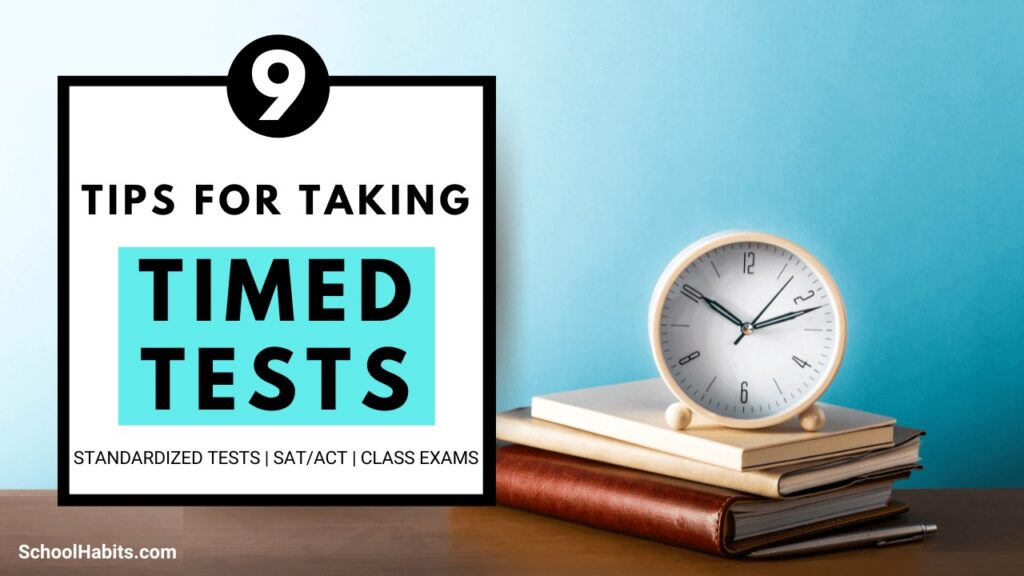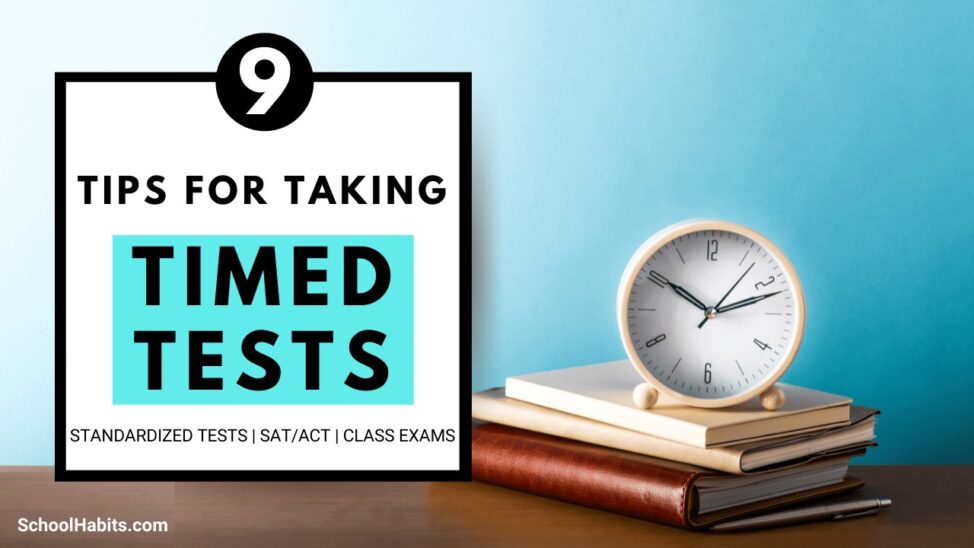By Katie Azevedo, M.Ed.

In this post, I’m sharing 9 tips for taking timed tests. Timed tests include standardized tests like the SAT, ACT, and AP exams; they also include school exams that have to be completed in one class period. Tests are naturally anxiety-producing – but throw in a ticking clock and it can be a whole new level of intensity.
Tips for taking timed tests
Just a friendly and realistic reminder that the following strategies work best when you’ve fully and adequately studied for the test you’re taking. No amount of timing techniques will save you from not knowing the material. I have approximately one bazillion “how to study” tutorials that can help. Also, if you’re not making and using cheat sheets by now (no, they’re not for cheating), you should be. Here’s how to make a cheat sheet.
1. Practice under simulated testing conditions.
This tip works like magic for timed standardized tests like the SAT, ACT, AP tests, GRE, etc. For these exams, you need to find previously released versions of the test (they’re available) and take them – multiple times – under simulated testing conditions. This is not a fun activity, but you need to do it regardless. To increase your pace for non-standardized tests, like a basic math exam, practice repeatedly doing problem sets in timed conditions – however long your class period is – until you can increase your timing without compromising your accuracy.
2. Immediately dump reference information on the page.
Immediately upon beginning your test, write down any information that you’re storing in your head that’s reference material. For example, if you’ve memorized a science or math formula for the test, write it down in the margins so you don’t forget it and can refer to it during the test. Or perhaps you’ve memorized a mnemonic device to recall the order of events for a history class; write down this mnemonic device before beginning the test. Have you memorized verb endings for your Spanish or French exam? Dump them in the margins/back of the test right away. This is an excellent time-saving technique.
3. Scan the test before answering any questions.
Know what you’re in for, know what’s ahead of you, and get a feel for what’s being asked of you. Take note of how many questions and sections there are, what types of questions there are, and generally the point value of each question. Also, notice if the test is double-sided; this information is important for establishing the right pace.
4. Identify the most important (high point value) task before starting the test.
As you’re scanning the test (Tip #3), take note of the largest task ahead of you. Is it an open response question? An essay? Word problems? Find it, and then estimate how long it will take you to complete. When there are that many minutes left in your testing time, finish up whatever question you’re on and then move immediately to the question you’ve identified as the most important.
5. Start with quick wins.
Bang out as many easy questions as you can. This might mean that you skip around the test a bit. It should only take a few seconds to identify a question as “easy” – if it’s taking longer than that, it’s not an easy question.
6. Take educated guesses on questions you’re uncertain about, and circle them with the intention of coming back to them.
If you feel moderately confident about answering a question, just go for it. After you take your educated guess, circle or mark the question in some way as a reminder of your intention to come back to it if there’s time at the end. If there is no time to return to the question, at least you have something as an answer.
7. Eliminate, think intensely and carefully, commit.
One of the best tips for timed tests is to start with the process of elimination, then think a little harder, and then just answer the question the best you can. In other words, put in a solid effort and then just call it. You may end up with an educated guess or a partially correct answer, but often that’s better than no answer at all.
8. Know when a question is a lost cause.
If you truly don’t know the answer to a question – like, not even a little bit – skip it entirely and move on. (exception: never leave multiple-choice questions blank on the SAT or ACT because there’s no guessing penalty.)
9. Keep your eye on the clock, but don’t obsess.
Occasionally check your watch or the clock to ensure you have enough time to complete the high-value task (Tip #4). However, avoid checking the time more than every 5-10 questions, as you’ll likely become more anxious. Speaking of anxiety, testing anxiety is a real thing. If you suffer from it, read this.
Final tip about taking timed tests
These tips for taking timed tests should help you manage your minutes during the testing experience. But there’s no substitute for proper preparation. The more you prepare for a test (the more effectively you study with these 22 study methods), the better your pace will be. If you have multiple tests to study for, I highly recommend using these study strategies.

